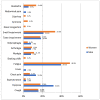Prevalence of Post COVID-19 Condition in Primary Care: A Cross Sectional Study
- PMID: 35162857
- PMCID: PMC8834857
- DOI: 10.3390/ijerph19031836
Prevalence of Post COVID-19 Condition in Primary Care: A Cross Sectional Study
Abstract
Background: The COVID-19 pandemic is a major challenge for health systems, citizens and policymakers worldwide. It is not known how many people are affected with longer term sequelae after acute COVID-19 and a wide range of prevalence estimates have been reported with a high heterogeneity between studies.
Methods: We designed a cross-sectional study to estimate the prevalence of post COVID-19 conditions in a community setting. We selected a random sample of 579 individuals from three different primary health care centers and collected information on symptoms through a standardized questionnaire.
Results: Our main study finding was an overall population prevalence of 14.34% (95% CI 11.58-17.46%) of post COVID-19. Only 9% of patients were hospitalized in our study. Prevalence was higher in women than men (15.63% versus 13.06%) and the most frequent persistent symptoms were fatigue (44.6%), smell impairment (27.7%) and dyspnea (24.09%).
Conclusions: The prevalence of post COVID-19 condition was lower than expected according to other studies published in the literature. The prevalence was higher in women than men, and the most frequent persistent symptoms were fatigue, smell impairment, and dyspnea.
Keywords: COVID-19; general practice; post-acute COVID-19 syndrome; primary health care; public health.
Conflict of interest statement
The authors declare no conflict of interest.
Figures
Similar articles
-
Prevalence and Predictors of Persistence of COVID-19 Symptoms in Older Adults: A Single-Center Study.J Am Med Dir Assoc. 2021 Sep;22(9):1840-1844. doi: 10.1016/j.jamda.2021.07.003. Epub 2021 Jul 19. J Am Med Dir Assoc. 2021. PMID: 34352201 Free PMC article.
-
Persistent effects of COVID-19 in patients hospitalized during the first wave of the pandemic: The impact of persistent fatigue on quality of life in a cross-sectional study.J Med Virol. 2023 Feb;95(2):e28491. doi: 10.1002/jmv.28491. J Med Virol. 2023. PMID: 36832543
-
High prevalence of SARS-CoV-2 infection among symptomatic healthcare workers in a large university tertiary hospital in São Paulo, Brazil.BMC Infect Dis. 2020 Dec 2;20(1):917. doi: 10.1186/s12879-020-05662-8. BMC Infect Dis. 2020. PMID: 33267836 Free PMC article.
-
Prevalence and Determinants of Immediate and Long-Term PTSD Consequences of Coronavirus-Related (CoV-1 and CoV-2) Pandemics among Healthcare Professionals: A Systematic Review and Meta-Analysis.Int J Environ Res Public Health. 2021 Feb 23;18(4):2182. doi: 10.3390/ijerph18042182. Int J Environ Res Public Health. 2021. PMID: 33672257 Free PMC article.
-
A public health approach to estimating the need for long COVID services.J Public Health (Oxf). 2023 Mar 14;45(1):169-175. doi: 10.1093/pubmed/fdab365. J Public Health (Oxf). 2023. PMID: 34651183 Review.
Cited by
-
Brain fog of post-COVID-19 condition and Chronic Fatigue Syndrome, same medical disorder?J Transl Med. 2022 Dec 6;20(1):569. doi: 10.1186/s12967-022-03764-2. J Transl Med. 2022. PMID: 36474290 Free PMC article.
-
Effectiveness of Using the FreeStyle Libre® System for Monitoring Blood Glucose during the COVID-19 Pandemic in Diabetic Individuals: Systematic Review.Diagnostics (Basel). 2023 Apr 21;13(8):1499. doi: 10.3390/diagnostics13081499. Diagnostics (Basel). 2023. PMID: 37189600 Free PMC article. Review.
-
Risk Factors Associated with Post-COVID-19 Conditions Among Diabetes Patients in the United Arab Emirates.J Epidemiol Glob Health. 2025 Jan 20;15(1):6. doi: 10.1007/s44197-025-00346-5. J Epidemiol Glob Health. 2025. PMID: 39833641 Free PMC article.
-
Comparison of observational methods to identify and characterize post-COVID syndrome in the Netherlands using electronic health records and questionnaires.PLoS One. 2025 Jan 29;20(1):e0318272. doi: 10.1371/journal.pone.0318272. eCollection 2025. PLoS One. 2025. PMID: 39879159 Free PMC article.
-
The Mental Health Impact of the COVID-19 Pandemic Second Wave on Shielders and Their Family Members.Int J Environ Res Public Health. 2022 Jun 15;19(12):7333. doi: 10.3390/ijerph19127333. Int J Environ Res Public Health. 2022. PMID: 35742580 Free PMC article.
References
-
- WHO Coronavirus (COVID-19) Dashboard WHO Coronavirus (COVID-19) Dashboard with Vaccination Data. [(accessed on 14 November 2021)]. Available online: https://covid19.who.int/
-
- Rauh A.L., Linder J.A. Covid-19 Care before, during, and beyond the Hospital. [(accessed on 8 December 2021)]. Available online: https://www.bmj.com/about-bmj/resources-readers/permissions.
-
- Fernández-de-Las-Peñas C., Palacios-Ceña D., Gómez-Mayordomo V., Cuadrado M.L., Florencio L.L. Defining Post-COVID Symptoms (Post-Acute COVID, Long COVID, Persistent Post-COVID): An Integrative Classification. [(accessed on 12 October 2021)];Int. J. Environ. Res. Public Health. 2021 18:2621. doi: 10.3390/ijerph18052621. Available online: https://pubmed.ncbi.nlm.nih.gov/33807869/ - DOI - PMC - PubMed
-
- Post-COVID Conditions: Information for Healthcare Providers. [(accessed on 8 December 2021)]; Available online: https://www.cdc.gov/coronavirus/2019-ncov/hcp/clinical-care/post-covid-c....
-
- A Clinical Case Definition of Post COVID-19 Condition by a Delphi Consensus, 6 October 2021. [(accessed on 8 December 2021)]. Available online: https://www.who.int/publications/i/item/WHO-2019-nCoV-Post_COVID-19_cond....
MeSH terms
LinkOut - more resources
Full Text Sources
Medical


